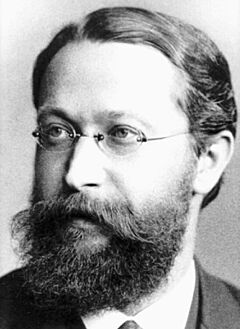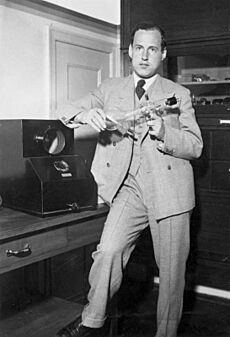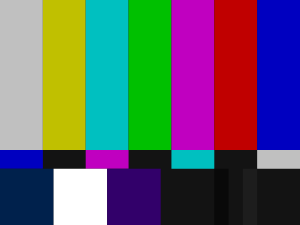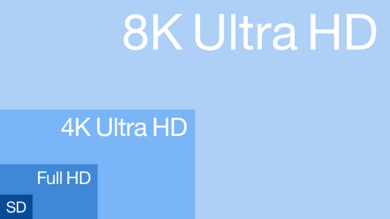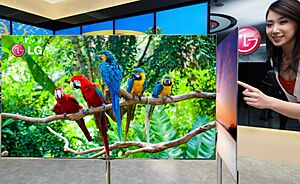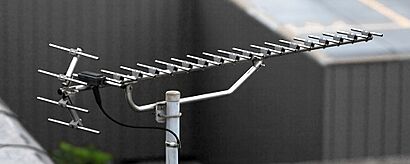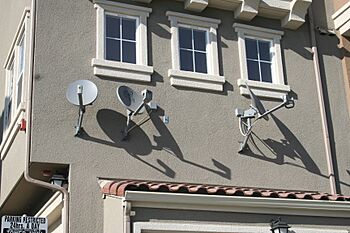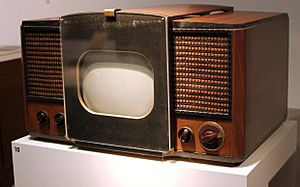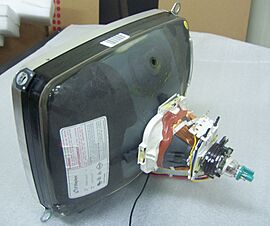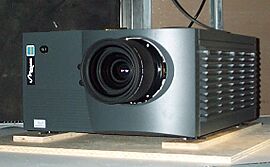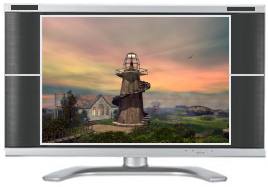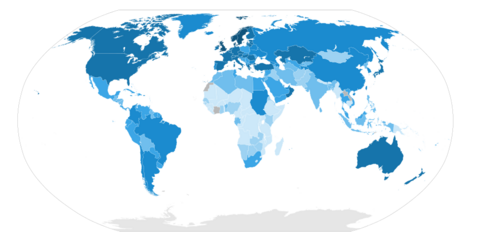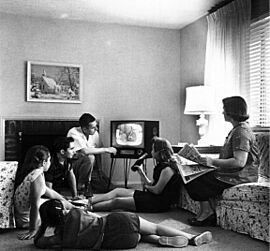Television facts for kids
Television (often called TV) is a way to send moving pictures and sounds over long distances. The word "television" can also mean the actual TV set you have in your home. TV is a huge part of our lives, used for ads, fun shows, news, and sports. It's different from radio, which only sends sound.
Early versions of TV appeared in the 1920s, but it took many years for the technology to get good enough for people to buy. After World War II, black-and-white TV became very popular in places like the UK and the US. TV sets quickly became common in homes. By the 1950s, TV was a main way to share information and influence people's ideas. In the mid-1960s, color TV started to become available in the US and other developed countries.
Over time, new ways to store TV shows and movies appeared, like VHS tapes, DVDs, and Blu-ray Discs. This meant people could watch their favorite shows and movies whenever they wanted. Now, many shows are stored "in the cloud" (online) through services like Netflix, making it super easy to watch things remotely. In the early 2010s, digital television became very popular. We also moved from standard-definition television (SDTV) to high-definition television (HDTV), which gives us much clearer pictures. Since 2010, smart televisions have made it possible to watch TV shows and movies directly from the internet using streaming services.
By 2013, about 79% of homes worldwide had a TV. Old, bulky cathode-ray tube (CRT) screens were replaced by thin, energy-saving flat screens like LCDs and OLED displays. Most TVs sold in the 2000s were still CRTs, but flat screens took over in the early 2010s. Now, smart televisions with internet features are the most common type of TV.
TV signals were first sent through the air using powerful radio transmitters to individual TV sets. Later, TV signals also started coming through cables, satellites, and now, the internet. Until the early 2000s, these signals were analog, but most countries have now switched to digital television. A TV set has many parts inside, including a tuner to receive and decode signals. A screen that doesn't have a tuner is called a video monitor, not a TV.
TV broadcasts are usually one-way. This means the sender cannot receive, and your TV cannot send signals back.
Contents
What Does "Television" Mean?
The word television comes from the Greek word τῆλε (tele), which means 'sight'. The first time this word was written down was in 1900. A Russian scientist named Constantin Perskyi used it in a paper he presented in Paris.
The English version of the word first appeared in 1907. Back then, it was just an idea for sending moving pictures using telegraph or telephone wires. People also suggested names like "telephote" (in 1880) and "televista" (in 1904).
The short form TV started being used in 1948. People started using "TV" to mean the actual "television set" in 1941. Using "TV" to mean the "television medium" (like watching shows) started in 1927. In the UK, people sometimes call it "telly."
How Television Was Invented
Early Mechanical TVs
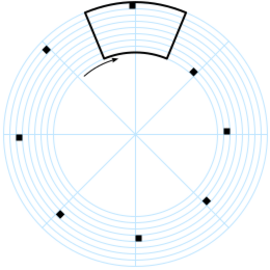
Before electronic TVs, people tried to send pictures using mechanical systems. In the early 1800s, fax machines for still photos used a method called mechanical scanning. Alexander Bain created a fax machine between 1843 and 1846.
In 1884, a 23-year-old German student named Paul Julius Gottlieb Nipkow invented and patented the Nipkow disk in Berlin. This was a spinning disk with a spiral of holes. Each hole would scan one line of an image. Even though Nipkow never built a working model, his idea of a spinning-disk "image scanner" became very common.
The first time live images were shown was in Paris in 1909 by Georges Rignoux and A. Fournier. They used a grid of 64 special cells to capture the image. In the receiver, a spinning disk with mirrors showed the image on a screen. This early system could only show 8x8 pixels, just enough to see individual letters.
In 1911, Boris Rosing and his student Vladimir Zworykin made a system that used a mechanical scanner to send very rough images over wires to a cathode-ray tube (CRT) screen. But moving images weren't possible yet because the parts weren't sensitive enough.
In 1921, Édouard Belin sent the first image using radio waves with his "belinograph."

By the 1920s, when technology improved, Scottish inventor John Logie Baird used the Nipkow disk in his TV systems. On March 25, 1925, Baird showed the first public demonstration of moving silhouette images in London. Since human faces didn't show up well on his simple system, he used a dummy named "Stooky Bill" with a high-contrast painted face.
On January 26, 1926, Baird showed members of the Royal Institution how to send a moving image of a face by radio. This is seen as the world's first real public TV demonstration, showing light, shade, and detail. Baird's system used the Nipkow disk to both scan and display the image. A bright light shone on the subject, and the spinning disk with lenses swept the image across a light-sensitive cell. This cell turned the light into an electrical signal, which was sent by radio waves to a receiver. The receiver had another Nipkow disk spinning in sync, with a neon light behind it. The light's brightness changed with the signal, recreating the image. Baird's disk had 30 holes, making a 30-line image, just enough to recognize a face.
In 1927, Baird sent a TV signal over 438 miles (705 km) of telephone line between London and Glasgow. His original "televisor" is now in the Science Museum in London.
In 1928, Baird's company sent the first TV signal across the Atlantic Ocean, from London to New York. They also sent the first signal from land to a ship. In 1929, he helped start the first experimental mechanical TV service in Germany.
An American inventor, Charles Francis Jenkins, also worked on early TV. In 1925, he used a Nipkow disk to send the silhouette of a toy windmill moving 5 miles (8 km) away.
In 1927, Herbert E. Ives and Frank Gray of Bell Labs showed off mechanical television. Their system could show clear, black-and-white moving images on both small (2x2.5 inches) and large (24x30 inches) screens. They also sent sound along with the pictures. The system sent images over both copper wire and radio, and viewers couldn't tell the difference in quality.
By 1927, Leon Theremin in the Soviet Union had developed a mirror-drum TV that could show 100 lines, which was very good for the time.
On December 25, 1926, Kenjiro Takayanagi in Japan showed a TV system with 40 lines that used a Nipkow disk and a CRT display. This was the first working electronic TV receiver.
Because mechanical TVs used disks with a limited number of holes, the picture quality was low, usually from 30 to about 120 lines. However, the quality improved over time. By 1933, UK broadcasts using Baird's system were quite clear. Mechanical TV was the main type until the 1930s, but it was eventually replaced by all-electronic systems. The last mechanical TV broadcasts in the US ended in 1939.
Electronic TVs Take Over
In 1897, English physicist J. J. Thomson discovered how to bend cathode rays, which is key to how modern cathode-ray tubes (CRTs) work. The first CRT was invented by German physicist Ferdinand Braun in 1897. It had a screen coated with a special material that glowed when hit by electrons. Braun was the first to think of using a CRT as a display. The "Braun tube" became the basis for 20th-century television.
In 1907, Russian scientist Boris Rosing used a CRT to show simple shapes in an experimental TV system.
In 1908, Alan Archibald Campbell-Swinton from the UK suggested using a CRT for both sending and receiving TV pictures. He expanded on this idea in 1911.
In 1926, Hungarian engineer Kálmán Tihanyi designed an electronic TV system that could store electrical charges in the camera tube. This solved the problem of camera tubes not being sensitive enough to light. His idea was used in RCA's "iconoscope" camera tube in 1931.
On September 7, 1927, American inventor Philo Farnsworth's image dissector camera tube sent its first image: a simple straight line. By 1928, Farnsworth showed his system to the press. Many consider this the first electronic TV demonstration. In 1929, he improved it so it had no mechanical parts. That year, Farnsworth sent the first live human images with his system.

Meanwhile, Vladimir Zworykin also worked on CRTs. In 1923, he started developing an electronic camera tube for Westinghouse Electric. However, his early demonstrations in 1925 showed dim, low-contrast, still images. RCA, which bought the Westinghouse patent, tried to claim that Farnsworth's invention was covered by Zworykin's earlier patent. But the US Patent Office decided in 1935 that Farnsworth was the first to invent it. RCA eventually agreed to pay Farnsworth to use his patents.
In 1933, RCA introduced an improved camera tube called the "Iconoscope," which used Tihanyi's charge storage idea. It was much more sensitive to light than Farnsworth's image dissector.
At the Berlin Radio Show in August 1931, Manfred von Ardenne showed the first completely electronic TV transmission, using CRTs for both sending and receiving. He didn't have a camera tube, so he used the CRT to scan slides and film. The world's first regular electronic TV service started in Berlin in 1935. It even broadcast the 1936 Summer Olympic Games live to public places across Germany.
Philo Farnsworth gave the world's first public demonstration of an all-electronic TV system with a live camera in Philadelphia in 1934. Mexican inventor Guillermo González Camarena also helped develop early TV. He patented a color television system in 1940.
In Britain, the EMI team, led by Isaac Shoenberg, developed a new camera tube called "the Emitron." On November 2, 1936, a 405-line TV service using the Emitron began broadcasting from Alexandra Palace in London. This was the world's first regular "high-definition" TV service.
The original US iconoscope had problems with noise and low signal quality. The EMI team improved it by developing the "super-Emitron" and "CPS Emitron" tubes in 1934. The super-Emitron was much more sensitive. It was used by the BBC for the first time on Armistice Day 1937, allowing the public to watch the King lay a wreath at the Cenotaph. This was the first time a live street scene was broadcast from cameras on a building.
In 1941, the United States adopted a 525-line TV standard. In 1944, the Soviet Union designed the world's first 625-line TV standard, which became a national standard in 1946. This 625-line concept was later used in the European standard.
Early electronic TV sets were big and heavy, using vacuum tubes. After the invention of the transistor, Sony founder Masaru Ibuka predicted in 1952 that TVs would become smaller and portable. The first fully transistorized, portable TV was the 8-inch Sony TV8-301, released in 1960. This changed TV from something families watched together to something individuals could watch alone.
Color Television Arrives
The idea of using three black-and-white images to create a color image was explored almost as soon as black-and-white TVs were built. In 1880, Maurice Le Blanc suggested a color system. Polish inventor Jan Szczepanik patented a color TV system in 1897. Another inventor, Hovannes Adamian, also experimented with color TV as early as 1907.
Scottish inventor John Logie Baird showed the world's first color transmission on July 3, 1928. He used spinning disks with different colored filters. Baird also made the world's first color broadcast on February 4, 1938.
The first practical hybrid color system was also developed by John Logie Baird. In 1940, he showed a color TV that combined a regular black-and-white screen with a spinning colored disk.
In 1939, Hungarian engineer Peter Carl Goldmark at CBS introduced an electro-mechanical system. It used a disk with red, blue, and green filters spinning inside the camera and a similar disk spinning in front of the CRT in the TV set. CBS began experimental color tests in 1940. These early color systems didn't work with existing black-and-white TVs.
A big challenge for color TV was making sure it didn't use too much radio space. In the US, the National Television Systems Committee approved an all-electronic system developed by RCA. This system separated the color information from the brightness information and reduced the color resolution to save space. This meant black-and-white TVs could still receive the signal and show it in black-and-white. Color TVs could decode the extra information to show color. This "compatible color" system was a major achievement.
The first color broadcast in the US happened on July 8, 1954. However, for the next ten years, most TV shows were still in black-and-white. It wasn't until the mid-1960s that color TVs started selling a lot, partly because many network shows switched to color in 1965. By 1972, all daytime network programs were in color.
Early color TVs were large and heavy. The GE "Porta-Color" set, introduced in 1966, was more compact and portable. The first fully transistorized color TV in the US was the Quasar in 1967. These made watching color TV more convenient.
By 1972, sales of color TVs finally passed black-and-white TV sales. Color broadcasting in Europe started later, in 1967, using the PAL format. By the mid-1970s, almost all TV stations were broadcasting in color.
Digital Television
Digital television (DTV) sends audio and video using digital signals, unlike older analog signals. Because digital signals can be compressed, DTV can fit more than one program into the same channel space. This was a huge step forward, like color TV was in the 1950s. DTV became possible in the 1990s because computers became powerful and affordable. Before that, sending uncompressed digital video would have needed too much bandwidth.
In the mid-1980s, Japanese companies were developing HDTV. Then, in 1990, a US company, General Instrument, showed that a digital TV signal was possible. This was so important that the FCC decided to wait for a digital standard.
The FCC made key decisions in 1990. They said the new TV standard had to be true HDTV, with at least twice the resolution of existing TVs. They also said the new digital signal had to be able to be "simulcast" on different channels, so people with old TVs could still watch.
The final standards allowed for different ways of scanning images. There was a debate between the electronics industry and the computer industry about whether to use "interlaced" or "progressive" scanning.
- Interlaced scanning was designed for older CRT screens. It scans odd lines first, then even lines, which helped reduce flickering.
- Progressive scanning, used by computers, scans every line in order from top to bottom. It creates a clearer image on newer screens like LCDs and is better for connecting to the internet.
The Digital television transition began in the late 2000s. Governments around the world set deadlines for turning off analog TV. At first, digital TVs were expensive, but as prices dropped, more homes switched. This change was mostly completed worldwide by the mid to late 2010s.
Smart TVs and 3D TVs
Digital TV led to smart televisions. A smart TV is a TV or set-top box with internet and Web 2.0 features built-in. It's like a mix of a computer, a TV, and a set-top box. Besides regular TV channels, smart TVs can offer internet TV, online games, and streaming video services. They come with their own operating system.
Smart TVs are different from Internet TV (watching TV content over the internet) or IPTV (a specific technology for internet TV). A patent for an "intelligent" TV system was filed in 1994. Major TV makers started producing smart TVs for their mid-range and high-end models in 2015. Smart TVs have become more affordable, and by 2019, 46 million US homes had at least one.
3D televisions try to make images look like they have depth. They use techniques like stereoscopic display, which often requires special glasses. The first 3D TV was made in 1935. While 3D TVs are popular for watching 3D movies at home, 3D TV channels largely failed to attract viewers and many shut down by the mid-2010s.
How TV Shows Get to You
TV Broadcasts from Antennas
TV shows are sent out by TV stations, sometimes called "channels." Governments give licenses to stations to broadcast over certain channels. At first, sending signals through the air (terrestrial broadcasting) was the only way to reach many people. Because there were only a few channels available, governments often regulated them.
WRGB claims to be the oldest TV station, starting as an experimental station in 1928 in Schenectady, NY. It was known as "WGY Television." On November 2, 1936, the BBC in London began the world's first regular high-definition TV service.
With the rise of cable TV in the US in the 1970s and 1980s, fewer people used antennas. However, after the switch to digital terrestrial television around 2010, which offered clear pictures, some people started using antennas again as an alternative to cable.
Cable TV
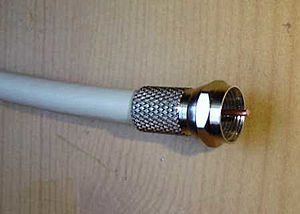
Cable television sends TV shows to paying customers using signals through coaxial cables or fiber-optic cables. This is different from traditional TV, where signals travel through the air to an antenna. Today, cable companies also offer FM radio, high-speed internet, and phone service through these cables. The term CATV originally meant "Community Antenna Television" because it started in areas where regular TV reception was poor. Large "community antennas" were built, and cables ran from them to individual homes.
Satellite TV
Satellite television delivers TV shows using signals sent from communication satellites in space. You receive these signals with an outdoor satellite dish and a special device called an LNB. A satellite receiver then decodes the signal for your TV. Satellite TV offers many channels, especially in areas where traditional TV or cable isn't available.
The most common way to get satellite TV is called "direct-broadcast satellite" (DBS). These systems send digital signals. Older satellite TV systems used larger dishes and received analog signals.
In 1945, science fiction writer Arthur C. Clarke suggested a worldwide communication system using three satellites in Earth orbit. The first satellite TV signals from Europe to North America were sent via the Telstar satellite in 1962. The first commercial communication satellite, "Early Bird," was launched in 1965.
Internet TV (Streaming)
Internet television (also called Internet TV or online television) means getting TV content over the internet, instead of through antennas, cable, or satellite. It's a general term for TV shows and videos delivered online using streaming video technology. Internet TV is not the same as Smart TV (a TV with internet built-in) or IPTV (a specific technology for internet TV networks).
Traditional cable and satellite TV providers have started offering their own streaming services, like Sling TV and DirecTV Stream. In 2013, Netflix became the first streaming service to get Emmy Award nominations for its original shows. By 2017, 28% of US adults said streaming services were their main way to watch TV. By 2018, Netflix was the world's largest streaming TV network. The COVID-19 pandemic in 2020 greatly increased TV streaming as people stayed home.
Television Sets
A television set, also called a TV, is a device that combines a tuner, screen, amplifier, and speakers to let you watch TV and hear its sound. Early TVs were mechanical, but after World War II, electronic TVs using cathode-ray tubes became popular. Color TV, after 1953, made them even more popular. In the 1970s, TVs became the main way to watch recorded movies on Betamax and VHS tapes. Later, people used them to watch DVDs and Blu-ray Discs. By the mid-2010s, manufacturers stopped making old CRT, DLP, plasma, and fluorescent-backlit LCD TVs. Most TVs since 2010 use LEDs, and OLEDs are expected to replace them soon.
Screen Technologies
CRT (Cathode-Ray Tube)
The cathode-ray tube (CRT) is a vacuum tube with electron guns and a glowing screen. It shoots electron beams onto the screen to create images. CRTs are large, deep, heavy, and fragile glass tubes. The front screen is usually made of thick lead glass to prevent shattering and block X-rays.
In TVs, the electron beams scan the screen in a pattern called a raster. An image is made by controlling the brightness of three electron beams (red, green, and blue) based on the video signal. Magnets around the tube's neck bend the beams to draw the picture.
DLP (Digital Light Processing)
Digital Light Processing (DLP) is a type of video projector technology. It uses a tiny chip with millions of small mirrors. Some DLP devices have a TV tuner, making them a type of TV. DLP was invented by Dr. Larry Hornbeck in 1987. It's used in projectors for classrooms, businesses, homes, and even in about 85% of digital cinema projectors.
Plasma Displays
A plasma display panel (PDP) is a type of flat-panel display often used for large TVs (30 inches or bigger). They are called "plasma" displays because they use small cells filled with electrically charged ionized gases. These cells are like tiny fluorescent lamps that glow to create the image.
LCD (Liquid-Crystal Display)
Liquid-crystal display televisions (LCD TVs) use liquid-crystal display technology to make images. LCD TVs are much thinner and lighter than old CRTs and can be made in much larger sizes. As they became cheaper to make, LCDs became popular for TVs. LCDs come in two types: those using fluorescent lamps for backlighting (simply called LCDs) and those using LEDs for backlighting (called LEDs).
In 2007, LCD TV sales passed CRT TV sales worldwide. LCDs quickly replaced plasma and rear-projection TVs. By the mid-2010s, LCDs (especially LEDs) were the most common TV display type.
OLED (Organic Light-Emitting Diode)
An OLED (organic light-emitting diode) is an LED where the light-emitting layer is a thin film of organic compounds. This film glows when electricity passes through it. OLEDs are used to make digital displays for TVs, computer monitors, and portable devices like mobile phones.
An OLED display doesn't need a backlight. This means it can show very deep blacks and can be thinner and lighter than an LCD. In a dark room, an OLED screen can have much better contrast than an LCD. OLEDs are expected to replace other display types soon.
Picture Quality (Resolution)
Low Definition (LD)
Low-definition television (LDTV) refers to TV systems with lower screen resolution than standard-definition, like 240p (320x240 pixels). It's often used in handheld televisions or for internet videos where higher resolution files would be too large to download quickly. Many mobile phones and portable devices use LDTV video because their screens are small.
Standard Definition (SD)
Standard-definition television (SDTV) refers to two main resolutions: 576i (576 interlaced lines) from European systems, and 480i from American systems. SDTV is not considered high-definition. In North America, digital SDTV is broadcast in the same 4:3 shape as older TVs. In other parts of the world, standard-definition TV is now usually shown in a wider 16:9 shape.
High Definition (HD)
High-definition television (HDTV) gives a much clearer picture than standard-definition TV.
HDTV can be sent in different formats:
- 1080p: 1920x1080 pixels per full picture.
- 1080i: 1920x1080 pixels, but interlaced (half the lines at a time).
- 720p: 1280x720 pixels per full picture.
Ultra High Definition (UHD)
Ultra-high-definition television (UHDTV), also known as Ultra HD, includes 4K UHD (2160p) and 8K UHD (4320p). These are digital video formats with very high resolution. The Consumer Electronics Association says "Ultra HD" means displays with a wide screen (at least 16:9) and a minimum resolution of 3840x2160 pixels.
TV Shows and How They're Paid For
Types of TV Shows
Television genres are the different types of shows that entertain, inform, and educate viewers. The most expensive shows to make are usually dramas and miniseries.
Popular entertainment shows include action shows like police, crime, or thriller dramas. There are also medical dramas and daytime soap operas. Science fiction shows can be dramas or action, depending on their focus. Comedy is popular, including sitcoms and animated series for adults.
Less expensive entertainment shows include game shows, talk shows, variety shows, and reality television. Game shows have contestants answering questions to win prizes. Talk shows feature interviews with famous people. Variety shows have different performers like musicians and comedians. Reality TV shows "regular" people facing challenges or doing everyday things.
Some TV shows are considered "quality television" by experts, like Twin Peaks or The Sopranos. These shows might have deep characters, complex stories, and unclear endings, similar to art films. Nonfiction "quality television" includes serious, non-commercial shows for specific audiences, like documentaries and public affairs programs.
How TV is Paid For
Around the world, TV broadcasting is paid for in different ways: by governments, through advertising, by license fees (a type of tax), by subscriptions, or a mix of these. To protect their money, subscription TV channels are usually scrambled so only paying customers can watch them. Channels that are not scrambled are called "free-to-air."
In 2009, there were over 1.2 billion homes with at least one TV worldwide. Most of the money for TV comes from advertising (45-50%) and subscription fees (40-45%), with public funding making up about 10%.
Advertising on TV
TV's wide reach makes it great for advertisers. Many TV networks sell time slots to advertisers to pay for their shows. A television advertisement (or commercial/ad) is a short video made and paid for by a company to sell a product or service. Ad money is a big part of how most private TV networks are funded. Most TV ads today are short, from a few seconds to several minutes.
The first official, paid TV ad was shown in the US on July 1, 1941, for Bulova watches. It showed a clock with the Bulova logo. The first TV ad in the UK was on September 22, 1955, for Gibbs SR toothpaste.
In the US, TV ad rates are mostly based on how many people are watching (measured by companies like Nielsen Media Research). The time of day and how popular the channel is determine the cost. For example, a 30-second ad during the Super Bowl can cost millions of dollars. Less popular times, like early mornings, are cheaper and often sold to companies that make long ads called "infomercials." Some shows also put products directly into their scenes as ads, which is called product placement.
In the UK, TV advertising is regulated. Major commercial channels can only show about seven minutes of ads per hour. News, children's programs, and religious shows cannot have ads during them. The BBC, which is not commercial, does not show ads on its UK channels. It is funded by an annual television license fee paid by people who own TVs.
Subscription Services
Some TV channels are partly paid for by subscriptions. Their signals are encrypted so that only paying subscribers can watch them. Most subscription services also have ads.
Government Funding or License Fees
In some countries, TV services are funded by a television licence fee or a tax. This means advertising plays a smaller role or no role at all. For example, the BBC in the UK has no ads on its UK channels and is funded by a license fee. The ABC in Australia also has no ads. In Japan, NHK is paid for by license fees.
How TV Affects Society
Television has been very important in shaping society in the 20th and 21st centuries. There are many ways TV can affect people, including negative things like media violence. Some research shows that people who feel lonely might use TV to create a "fake relationship" with characters from their favorite shows.
However, educational television has many benefits. TV can be a powerful learning tool for children if used wisely. Many religious groups also use TV for broadcasting their messages.
Safety Concerns
Young children, especially those aged five or younger, are at risk of injury from falling TVs. Older, heavy CRT-style TVs can hit with a lot of force if they fall. Newer flat-screen TVs are "top-heavy and have narrow bases," making them easy for a small child to pull over. By 2015, TV tip-overs caused over 10,000 injuries to children in the US each year.
A 2017 study found that watching cable TV reduced thinking skills and high school graduation rates for boys, especially those from more educated families. This might be because light TV entertainment takes time away from more challenging activities.
There are also environmental concerns. Old CRTs contain a lot of lead, and some newer LCDs use lamps with mercury. This leads to worries about electronic waste when TVs are thrown away. Also, TVs use more and more electricity, which is another environmental concern.
Images for kids
See also
- B-television
- Broadcast-safe
- Broadcast television systems
- Content discovery platform
- Information-action ratio
- List of countries by number of television broadcast stations
- List of television manufacturers
- List of years in television
- Lists of television channels
- Media psychology
- MicroLED
- Sign language on television
- Telephilia
- Television addiction
- Television studies
- Test card
- TV accessory
 In Spanish: Televisión para niños
In Spanish: Televisión para niños



